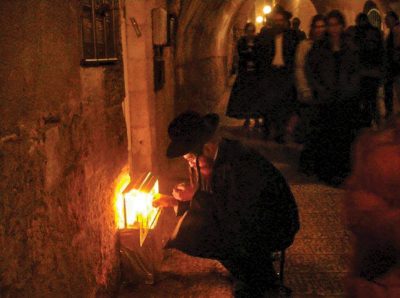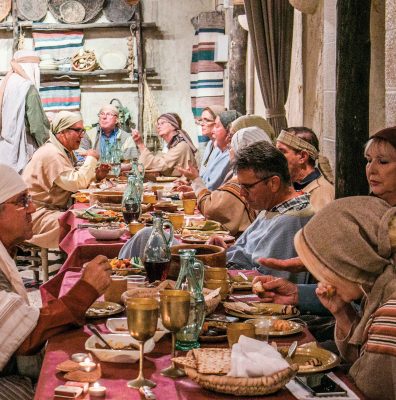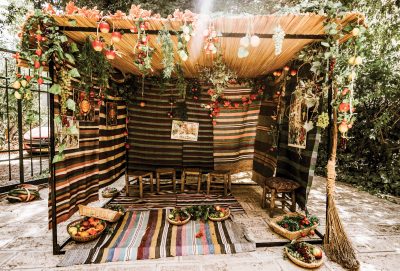×


We have detected your country as:
Please click here to go to the USA website or select another country from the dropdown list.
by: Joshua Spurlock, The Mideast Update
 When you visit Israel, you can see the Bible come to life. This is the land where Jesus walked on water and where David wrote the Psalms. But when you visit Israel during one of the biblical holidays or the extra-biblical festivals of Hanukkah (Feast of Dedication or Festival of Lights) and Purim (Feast of Esther), you will see more than just the land of the Bible; you will experience life as it was in biblical times and see how modern Israelis are living out the Bible today. With fun foods, all-night Bible studies and streets clear of traffic but full of people dressed in white, visiting Israel during these holidays is an experience unlike any other.
When you visit Israel, you can see the Bible come to life. This is the land where Jesus walked on water and where David wrote the Psalms. But when you visit Israel during one of the biblical holidays or the extra-biblical festivals of Hanukkah (Feast of Dedication or Festival of Lights) and Purim (Feast of Esther), you will see more than just the land of the Bible; you will experience life as it was in biblical times and see how modern Israelis are living out the Bible today. With fun foods, all-night Bible studies and streets clear of traffic but full of people dressed in white, visiting Israel during these holidays is an experience unlike any other.
The major biblical holidays are listed in Leviticus 23. The first holiday on the Jewish calendar is the Feast of Passover, or Pesach in Hebrew. This holiday commemorates the Exodus of the Children of Israel from Egypt, but it also marks the Last Supper and death of Jesus (Yeshua). Matthew 26 tells of Jesus’s last meal with His disciples in which He inaugurates the bread and wine tradition that Christians regularly observe today. Scriptures say this Last Supper was a Passover meal.
 So if you’re in Israel during Pesach, try to locate a family or a group hosting a Passover meal—known in Hebrew as a seder—and experience an event very much like the Last Supper. During the week that follows, the holiday continues as the Feast of Unleavened Bread, during which no leaven is eaten. You can, however, find kosher (food satisfying the requirements of Jewish law) restaurants and bakeries creatively providing for you to have a burger on a “bun” or have your “cake” and eat it too. A trip to the Western Wall is also in order. One morning during this holiday, tens of thousands of Jews come to hear the biblical “Priestly Blessing” from Numbers 6:24–26, delivered by modern descendants of the Aaronic priesthood.
So if you’re in Israel during Pesach, try to locate a family or a group hosting a Passover meal—known in Hebrew as a seder—and experience an event very much like the Last Supper. During the week that follows, the holiday continues as the Feast of Unleavened Bread, during which no leaven is eaten. You can, however, find kosher (food satisfying the requirements of Jewish law) restaurants and bakeries creatively providing for you to have a burger on a “bun” or have your “cake” and eat it too. A trip to the Western Wall is also in order. One morning during this holiday, tens of thousands of Jews come to hear the biblical “Priestly Blessing” from Numbers 6:24–26, delivered by modern descendants of the Aaronic priesthood.
Fifty days after Passover is the Festival of Weeks, or Shavuot in Hebrew. In certain Bibles, it’s also known as Pentecost. In Judaism, it is believed to commemorate the giving of the Ten Commandments to Moses at Mount Sinai. In honor of that illustrious occasion, it is traditional to stay up all night studying the Bible. In Jerusalem today, that means that on the night of Shavuot (Jewish events always start the night before the day marked on a Gregorian calendar) you can travel from place to place all night, listening to teachings or religious songs with crowds of people, including groups dressed in traditional white. It’s like an all-night progressive dinner with a very holy, Bible-focused atmosphere.
Like any good all-night party, it continues until the sun comes up. Crowds make their way to the Western Wall for morning prayers, and you may even end up with a light, free breakfast courtesy of religious Jews handing out food in the plaza near the Wall.
The Jewish New Year, Rosh HaShanah—or in the Bible, the Festival of Blowing, referring to the trumpet-like shofar (ram’s horn)—comes towards the end of summer. It is traditional to hear the shofar blown 100 times on this day, so if you step into a synagogue or head down to the Western Wall, chances are you’ll hear the powerful blast of a skilled trumpeter.
Rosh HaShanah begins the Ten Days of Awe—a meaningful period of introspection and repentance that culminates in Yom Kippur, or the Day of Atonement. While it is traditionally a day of fasting, there is still a buzz of excitement in the air in Jerusalem for the holiest day of the year. The evening of Yom Kippur begins with the moving Kol Nidrei prayer service. After the services end, throngs of people—again dressed in the traditional white—make their way to the Western Wall.
This time, however, they walk in the middle of the street. In Jewish observant areas, cars are not driven on Shabbat (Sabbath) or Sabbath-like holidays, and Yom Kippur is the holiest of them all. Aside from the occasional emergency vehicle, the streets in Jerusalem are empty of all traffic. Instead, children play in what are normally busy intersections while crowds stroll down the middle of main thoroughfares. At the end of Yom Kippur the following evening, crowds pray at the Western Wall and then break their fast with free juice and light snacks as they wait for dozens of restaurants to unlock their doors for the hungry worshipers—even though it’s after dark.
 Just days after the biggest day of fasting comes the grand Feast of Tabernacles, or Sukkot in Hebrew. This holiday’s distinctive feature is the ubiquitous small, hut-like booths, known in Hebrew as a sukkah, which is also the reason for the holiday’s name (sukkot is the plural of sukkah). Leviticus 23 calls for Israelis to dwell in these booths or sukkot for the seven days of this holiday. In Jerusalem, they are everywhere, from apartment balconies, rooftops and common areas to enormous public versions at the Western Wall plaza. Kosher restaurants all over the city will set them up too. Sukkot is the biggest party of the year, so there are decorations, concerts and other festivities. Another round of the Priestly Blessing is given at the Western Wall, as enormous crowds that fill the plaza lsten.
Just days after the biggest day of fasting comes the grand Feast of Tabernacles, or Sukkot in Hebrew. This holiday’s distinctive feature is the ubiquitous small, hut-like booths, known in Hebrew as a sukkah, which is also the reason for the holiday’s name (sukkot is the plural of sukkah). Leviticus 23 calls for Israelis to dwell in these booths or sukkot for the seven days of this holiday. In Jerusalem, they are everywhere, from apartment balconies, rooftops and common areas to enormous public versions at the Western Wall plaza. Kosher restaurants all over the city will set them up too. Sukkot is the biggest party of the year, so there are decorations, concerts and other festivities. Another round of the Priestly Blessing is given at the Western Wall, as enormous crowds that fill the plaza lsten.
The Sukkot holiday season culminates in Simchat Torah, or Rejoicing in the Torah (Gen.–Deut.). This holiday includes crowds of religious Jews dancing with the traditional Torah scrolls at the Western Wall.
In addition to the Leviticus 23 holidays, the festival of Purim from the Book of Esther is a national costume party in Israel, with people of all ages dressing up to celebrate the Jewish people overcoming extermination at the hands of Haman. In the winter, Hanukkah is marked with eating jelly-filled doughnuts known in Hebrew as sufganiyot and lighting hanukkiot (nine-branched candelabras) all over the country. Touring a religious neighborhood is a site to behold.
It’s always a good time to visit Israel. But if you time it right, you’ll get a chance to see more than the land of the Bible—you’ll experience the life of the Bible.
Photo Credit: bridgesforpeace.com
All logos and trademarks in this site are property of their respective owner. All other materials are property of Bridges for Peace. Copyright © 2024.
Website Site Design by J-Town Internet Services Ltd. - Based in Jerusalem and Serving the World.